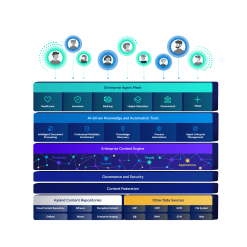Strategies for effective unstructured data management
Once an organization understands the challenges, several strategies can be employed for effective unstructured data management:
Defining requirements and governance
Effective management begins with defining clear goals for data collection and use. From there, organizations must implement a robust governance framework that covers data quality, security, and availability. This framework is the essential foundation for trustworthy and effective AI governance.
Data privacy and ownership are critical in the age of AI. All customer data should be housed in segregated tenants, and federation capabilities used to ensure the strict separation of information.
Hyland and AI governance
Hyland helps organizations apply robust AI governance controls, ensuring the right people and models access the right data. This allows organizations to tune how AI responds, ensuring compliance, reducing risk, and improving trust and adoption.
Enhancing discoverability with metadata
For AI to understand your content, its metadata must be enriched with context. This process involves using AI to add deeper layers of meaning, such as identifying topics, business entities and relationships between documents.
Hyland Knowledge Enrichment uses AI to add semantic vectors, topic hierarchies and quality metrics to your metadata. This provides the critical context AI agents need to perform better, leading to smarter decisions and improved performance.
> Read more | What is metadata and why is it important?
Unify access to your data
To gain a complete view of your enterprise knowledge, you must bring information together from across scattered systems. This eliminates the data silos that slow down analysis and innovation, making your content more accessible for AI systems.
Unifying data with Hyland
Hyland solutions don’t require costly and disruptive data migrations. A content lake can serve as the starting point for this transformation, allowing you to provide unified access to your information in place.
> Read more | Powering your content with AI
Automate data discovery and extraction
To make unstructured content usable, organizations must first automatically identify, classify and extract key information from it. This process uses AI-powered techniques like natural language processing (NLP) and optical character recognition (OCR) to process high volumes of documents with improved speed and quality.
Hyland IDP delivers AI-powered agentic document processing to automate these tasks. The solution intelligently classifies different document types, separates packets of multiple documents into individual files, and extracts critical data to feed your business processes, minimizing manual intervention. And because it leverages large language AI models (LLMs), Hyland IDP can do all this without extensive training required by legacy capture solutions, drastically accelerating your time to value.
Curate data for AI consumption
Raw data must be cleaned, structured and standardized so that AI tools can process it with speed and accuracy. This data curation process transforms varied content into a consistent, AI-ready format that systems can easily understand and act upon.
Hyland’s content intelligence tools help curate your data, ensuring the output is structured and prepared for AI. This is the essential step that transforms raw content into a reliable, AI-ready asset.

















